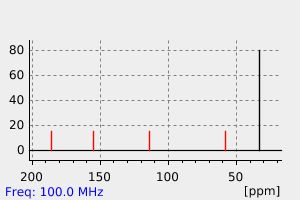InChI=1/C5H5N3S2/c1-8-4(7)3(2-6)10-5(8)9/h7H2,1H | 81403-18-1
中文名称
——
中文别名
——
英文名称
InChI=1/C5H5N3S2/c1-8-4(7)3(2-6)10-5(8)9/h7H2,1H
英文别名
4-amino-3-methyl-2-sulfanylidene-1,3-thiazole-5-carbonitrile
CAS
81403-18-1
化学式
C5H5N3S2
mdl
MFCD09539367
分子量
171.247
InChiKey
FJFRYEKHLCSEOJ-UHFFFAOYSA-N
BEILSTEIN
——
EINECS
——
-
物化性质
-
计算性质
-
ADMET
-
安全信息
-
SDS
-
制备方法与用途
-
上下游信息
-
文献信息
-
表征谱图
-
同类化合物
-
相关功能分类
-
相关结构分类
计算性质
-
辛醇/水分配系数(LogP):1.1
-
重原子数:10
-
可旋转键数:0
-
环数:1.0
-
sp3杂化的碳原子比例:0.2
-
拓扑面积:110
-
氢给体数:1
-
氢受体数:4
上下游信息
-
下游产品
中文名称 英文名称 CAS号 化学式 分子量 —— 4-Amino-3-methyl-3-thioxo-Δ4-thiazolin-5-thiocarboxamid 82013-38-5 C5H7N3S3 205.329
反应信息
-
作为反应物:描述:InChI=1/C5H5N3S2/c1-8-4(7)3(2-6)10-5(8)9/h7H2,1H 在 硫化氢 、 三乙胺 作用下, 以 吡啶 为溶剂, 反应 10.0h, 以75%的产率得到4-Amino-3-methyl-3-thioxo-Δ4-thiazolin-5-thiocarboxamid参考文献:名称:Zur Chemie der 4-Amino-thiazolin-2-thione, 2. Mitt.摘要:6-Amino-thiazolo[4,5-c]isothiazole derivatives 4 are obtained by addition of hydrogen sulfide to the 4-Amino-thiazoline-5-carbonitrile 2 followed by cyclooxidation of the intermediate thioamides 3. In the presence of sodium sulfite the hydrolysis of the 4-amino-2-methylthio-thiazolium salts 5 derived from the title compounds 1 yields the 4-amino-thiazolin-2-ones 6. By their further hydrolysis the 2,4-dioxo-thiazolidin-5-carboxamides 8 are formed. The 2-oxo-and 2-thioxo-thiazolo [4,5-d]pyrimidin-7-ones and -thiones available from 1 undergo ring opening by hydrolysis to give the substituted 4-amino-6-oxo- and 4-amino-6-thioxo-pyrimidine-5-thiols 15a-h and 13i-e. They have been isolated as their disulfides 14 or 5-alkyl derivatives i.e. the substituted 4-amino-5-alkylthiopyrimidin-6-ones and -thiones 16. In analogy, the intermediate 6-amino-7-oxo-thiazolo[4,5-d] pyrimidin-2-thione 18 and the 7-amino-thiazolo[4,5-d]-pyrimidin-2-thione 24 derived from 1 react by ring cleavage to yield the 1,4- and 4,6-diamino-pyrimidin-5-thiole derivatives 22 and 27, respectively, isolated as their disulfides or alkylthio-derivatives. From the pyrimidine 16b the pyrimido[5,4-b]1,4-thiazine derivative 18 can be obtained.DOI:10.1007/bf00811521
文献信息
-
Zur Chemie der 4-Aminothiazolin-2-thione作者:Karl Gewald、Ute Hain、Petra HartungDOI:10.1007/bf00900005日期:1981.12
-
Gewald K., Hain U., Schindler R., Gruner M., Monatsh. Chem, 125 (1994) N 10, S 1129-1143作者:Gewald K., Hain U., Schindler R., Gruner M.DOI:——日期:——
-
GEWALD, K.;HAIN, U.;HARTUNG, P., MONATSH. CHEM., 1981, 112, N 12, 1393-1404作者:GEWALD, K.、HAIN, U.、HARTUNG, P.DOI:——日期:——
表征谱图
-
氢谱1HNMR
-
质谱MS
-
碳谱13CNMR
-
红外IR
-
拉曼Raman
-
峰位数据
-
峰位匹配
-
表征信息
同类化合物
(SP-4-1)-二氯双(1-苯基-1H-咪唑-κN3)-钯
(5aS,6R,9S,9aR)-5a,6,7,8,9,9a-六氢-6,11,11-三甲基-2-(2,3,4,5,6-五氟苯基)-6,9-甲基-4H-[1,2,4]三唑[3,4-c][1,4]苯并恶嗪四氟硼酸酯
(5-氨基-1,3,4-噻二唑-2-基)甲醇
齐墩果-2,12-二烯[2,3-d]异恶唑-28-酸
黄曲霉毒素H1
高效液相卡套柱
非昔硝唑
非布索坦杂质Z19
非布索坦杂质T
非布索坦杂质K
非布索坦杂质E
非布索坦杂质D
非布索坦杂质67
非布索坦杂质65
非布索坦杂质64
非布索坦杂质61
非布索坦代谢物67M-4
非布索坦代谢物67M-2
非布索坦代谢物 67M-1
非布索坦-D9
非布索坦
非唑拉明
雷非那酮-d7
雷西那德杂质2
雷西纳德杂质L
雷西纳德杂质H
雷西纳德杂质B
雷西纳德
雷西奈德杂质
阿西司特
阿莫奈韦
阿考替胺杂质9
阿米苯唑
阿米特罗13C2,15N2
阿瑞匹坦杂质
阿格列扎
阿扎司特
阿尔吡登
阿塔鲁伦中间体
阿培利司N-1
阿哌沙班杂质26
阿哌沙班杂质15
阿可替尼
阿作莫兰
阿佐塞米
镁(2+)(Z)-4'-羟基-3'-甲氧基肉桂酸酯
锌1,2-二甲基咪唑二氯化物
锌(II)(苯甲醇)(四苯基卟啉)
锌(II)(正丁醇)(四苯基卟啉)
锌(II)(异丁醇)(四苯基卟啉)







